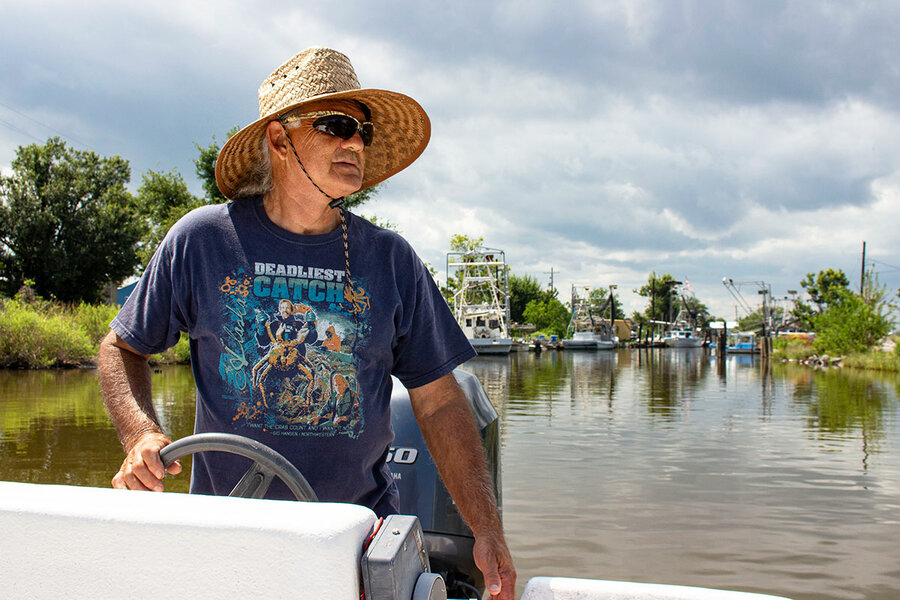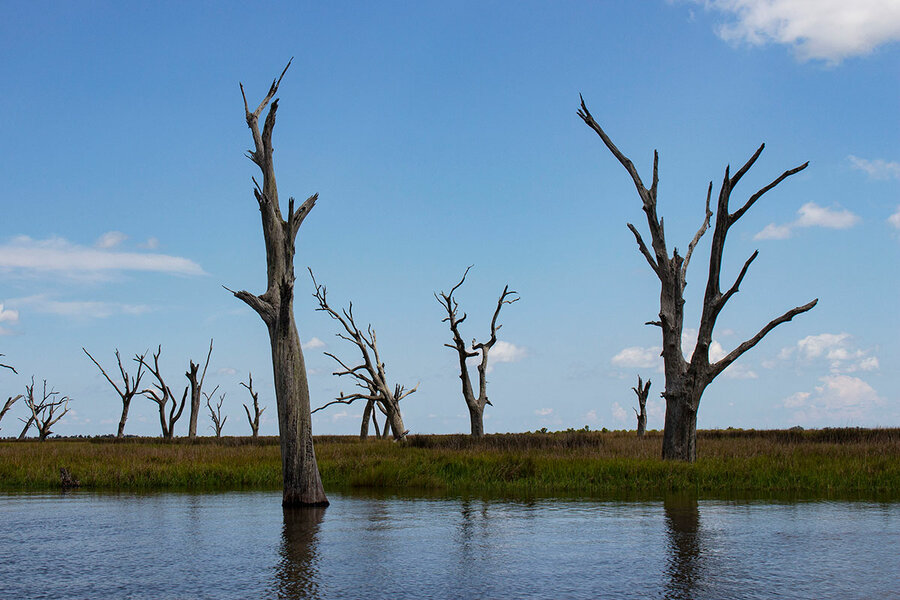A sinking community turns to oyster shells – and a tax – for safety
Loading...
| POINTE-AUX-CHENES, LA.
Donald Dardar navigates his skiff boat through the bayou as dark rain clouds gather, ready to unleash across Terrebonne Parish, Louisiana. His wife, Theresa, sits at the bow and points to an abandoned home. Two years ago, Hurricane Ida blew off its roof. Living here, where the Mississippi River flows into the Gulf of Mexico, residents find little easy protection from the elements.
The terrain of southeast Louisiana has been drastically altered by the combination of hurricanes, sea-level rise, and the construction of canals during the past half-century. And yet for years, the sparsely populated area was overlooked by state and federal coastal protection projects.
Why We Wrote This
A story focused onAs hurricanes, human engineering, and climate change threaten to wash their land away, residents of coastal Louisiana have rallied their own money and labor to build resilience.
So over the past two decades, residents, including the Dardars, members of an Indigenous tribe whose ancestors lived here for thousands of years, have begun trying to take the future of their land into their own hands.
Through a tax on themselves, Terrebonne Parish residents have funded the start of a major new levee as a shield from extreme weather. Construction is now continuing with federal aid as well. More recently, they have begun coastal restoration projects to protect key lands. Bags of discarded oyster shells from restaurants, placed along shorelines, become a home to new marine life and a barrier to erosion.
It’s a long-term battle with no guarantee of success, but residents say the efforts are making a difference.
Donald Dardar navigates his skiff boat through the bayou as dark rain clouds gather, ready to unleash across Terrebonne Parish, Louisiana. His wife, Theresa, sits at the bow and points to an abandoned home. Two years ago, Hurricane Ida blew off its roof. Living here, where the Mississippi River flows into the Gulf of Mexico, residents find little easy protection from the elements.
The terrain of southeast Louisiana has been drastically altered by the combination of hurricanes, sea-level rise, and the construction of canals and levees during the past half-century. And yet, the sparsely populated area had been repeatedly overlooked by state and federal coastal restoration and protection projects.
As a result, the Dardars, members of the Pointe-au-Chien Indian Tribe whose ancestors lived here for thousands of years, have watched their homeland wash away at an alarming rate. Ms. Dardar gestures to a narrow strip of wetland where live oaks, killed by saltwater intrusion, jut from the grasses.
Why We Wrote This
A story focused onAs hurricanes, human engineering, and climate change threaten to wash their land away, residents of coastal Louisiana have rallied their own money and labor to build resilience.
“The land used to go much farther back, with many more trees, and cows would roam there,” she says. As water salinity increased, duck sightings and freshwater fishing in the bayou have become things of the past.
So in 2001, Terrebonne Parish residents decided to act. They funded their own levee – with construction now well underway – and have more recently begun coastal restoration projects to protect key lands from erosion. It’s a long-term battle with no guarantee of success, but so far, the levee and rows of oyster shell-filled bags along the coast seem to be working.
“People started to realize there was no help coming to us and that we must help ourselves,” says Norby Chabert, a former three-term state senator for Terrebonne and the neighboring Lafourche Parish, in a phone interview. The consequences were clear if they didn’t act. Just 4 miles away, more than 98% of Isle de Jean Charles has already disappeared. Nearly all the families living there have relocated. “It was a matter of survival,” he says.
The efforts by Terrebonne Parish residents to stay above water are a window into how low-lying communities are responding to rapid coastal erosion with multi-pronged approaches. While strategies may vary from state-assisted “managed retreat” to big-money federal infrastructure projects, they also come down to locals learning how to work together and make hard choices.
A recent crisis with a long history
Roughly a football field of wetlands disappears every 100 minutes in coastal Louisiana and the Mississippi River Delta. Beyond devastating ecosystems, the changing landscape has contributed to almost a century of rising flood risks.
“There were a lot of canals that were cut for oil and gas drilling in the 1930s, which likely contributed to Louisiana sinking,” says Alex Kolker, an oceanographer, geologist, and climate scientist, whose research lab is based in Terrebonne Parish. “In addition, the area doesn’t get much sediment from the Mississippi River. This area was naturally cut off, positioned along a limb of the river that was receiving less and less river water. That’s also what led to the saltwater intrusion that kills freshwater vegetation,” he explains.
Climate change has also contributed to the region’s environmental emergency, though its effects have only been tangible in southern Louisiana since the 1990s, says Dr. Kolker.
“Skin in the game”
“It only became a crisis in my lifetime,” says Mr. Chabert, who is in his late 40s. It took a long time for reality to set in. There was a sentiment of disbelief, he says. People were used to living off the land, following crawfish, alligator, crab, shrimp, and duck seasons. But low yields set off alarms.
Storms also pushed the parishes to recognize their precarity. By 1985, home-devouring floods struck every few years instead of every few decades.
In 1992, the federal government authorized an assessment of the region’s hurricane protection needs. By 2000, “minimal” work had been done, says Reggie Dupre, a former state senator and director of the Terrebonne Levee & Conservation District.
So a year later, he and five politicians and businesspeople from Terrebonne Parish asked then-Louisiana Gov. Mike Foster how to build their own levee. “I don’t believe in handouts, but I do believe in helping hands,” Mr. Dupre recalls the governor saying. They struck a deal: The parish would raise a levee tax, and the state would match it dollar for dollar. It worked. The tax passed by a slim margin.
“We had to show we had skin in the game,” says Jerome Zeringue, who was levee district director at the time. In Republican strongholds like Terrebonne, convincing the public to add their first local sales tax was no easy task. “We had to develop public trust and to establish credibility in the levee district,” says Mr. Zeringue.
Since then, the parish has built on its momentum of cooperation and trust. Before federal money was made available through the bipartisan infrastructure law in 2021, Terrebonne Parish built approximately $600 million of the Morganza to the Gulf Hurricane Protection System – enough to start making a difference, although significant portions of the planned 98-mile system remain unfinished.
If asked, Terrebonne residents would raise the levee tax in a heartbeat, says Mr. Chabert.
Oysters, trees, and more soil
But the Dardars felt more needed to be done to stop erosion. Levees protect the community from storms but do little to stop erosion within them.
“This land is where a lot of our ancestors are buried,” Ms. Dardar says as the skiff approaches one of Pointe-au-Chien Indian Tribe’s sacred burial grounds, at risk of washing away. “All these mounds, we have a connection to them. ... We don’t want our ancestors’ hard work to be forgotten,” she says.
The Dardars spent four years searching for a solution. In 2019, they secured a grant to build their first “living shoreline” around a mound in the neighboring Lafourche Parish. Partnering with Louisiana nonprofit Coalition to Restore Coastal Louisiana, they now regularly collect 30-pound bags of oyster shells from New Orleans restaurants and place them where mound land runs into canal waters.
Oyster spat (seeds) circulate throughout the water, fasten to the empty oyster shells, and grow. Eventually, the beds become large enough to house other life, like crabs and fish, and strong enough to keep water from reaching the burial mounds.
For their efforts, the Dardars were recognized in June 2023 by the nonprofit coalition with a Coastal Stewardship Award. (Mr. Dupre, the former state senator, won a Lifetime Achievement award at the same time.)
Other Terrebonne residents – many of them members of the region’s five Indigenous communities – have followed in the Dardars’ footsteps. With grants and nonprofit partnerships, residents have organized tree plantings and projects to push dirt back into old canals. These aim to prevent further erosion, and gradually restore marshland and natural sedimentation.
Gardner Goodall, who is native plants coordinator for the Coalition to Restore Coastal Louisiana and has worked on a number of projects with the Dardars, is inspired by Terrebonne residents’ intimate connection to land and commitment to preservation. “There is no silver bullet” in addressing climate change and coastal erosion, he says. “I think it’s kind of beautiful the way we’re addressing coastal restoration here. We need bulldozers and cranes for big infrastructure projects, and we also need volunteers on the ground. Neither one of them can work on its own,” he says.
In fact, to some extent, this community-driven approach to coastal protection and restoration is turning traditional power dynamics on their heads, says Devon Parfait, chief of the Grand Caillou/Dulac band of Biloxi Chitimacha Choctaw, a sister tribe to the Pointe-au-Chien. “Typically we see a top-down approach, with big institutions making decisions with little to no community input,” he says. When there is work in underfunded communities, “it’s treated as a check box. ... Community outreach happens after the creative process and big decisions have already been made.”
Terrebonne may not be the most densely populated parish, but it’s home to cultures that exist nowhere else. Its seafood and energy industries help feed and fuel the country, and its ecosystem is essential to the planet, Mr. Parfait explains.
In contrast with the top-down approach of doing things “for the greater good,” where resources are allocated to the greatest number of people, he says, “I’m not approaching things for the greater good, but for the good of all.”











